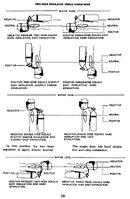What Captain described in Post #15 is the basis of the Cousteau-Gagnan patent for the Aqualung. But concerning the pressure in the hoses, what Duckbill is describing is that the ambient pressure at 270 feet of sea water is at least 135 psi. 270 feet divided by 33 feet per atmosphere is 8.18 atmospheres (gauge; it is actually 9.18 atmospheres absolute--with the atmosphere itself counted). If you then multiply that 9.18 atmospheres absolute by 14.7 psi per atmosphere, you get 134.946 psi absolute, or 135 psi absolute.
But, and this is significant, there is not 135 psi difference between the inside hose pressure and the outside ambient water pressure, as both sides of the hose experience approximately the same pressure. There is at most about 12 inches of water pressure difference due to positional differences between the mouthpiece and the LP diaphragm of the regulator. I was taught that there is a difference in water pressure for salt water (it's slightly less for fresh water) of 0.445 psig per vertical foot. So the difference between the ambient water pressure and the mouthpiece is probably at most 0.445 psig. Therefore, the greatest pressure which would be on a double hose regulator would most likely be about half a psi (0.5 psig). By the way, there is a slight difference between the exhaust mushroom of most single hose regulators and the center of the diaphragm, which in some positions can cause a single hose regulator to leak air if it is extremely well tuned--has less than about 3/4 inch breaking pressure.
The diagram in Let's Go Diving by Bill Barada is a little different, in that it shows the difference between the demand second stage diaphragm and the center of the lungs. This is how we as divers sense ease of breathing--the difference between the lung pressure and the regulator's LP diaphragm placement in the water column. This diagram is meant to show the difference between the single hose and the double hose for different positions. In a "normal" swimming position, the double hose regulator has "negative pressure, two hose--equals hard inhalation, easy exhalation." For a single hose regulator, "positive single-hose equals easy inhalation, hard exhalation." It was the hard exhalation which kept the single hose regulator from being accepted by the U.S. Navy for many years--not until the AMF Voit MR-12 came along did the U.S. Navy accept a single hose regulator; it had a larger exhaust than its competitors, and forced U.S. Divers to come up with a modified Conshelf and the third generation of the Calypso.
SeaRat





